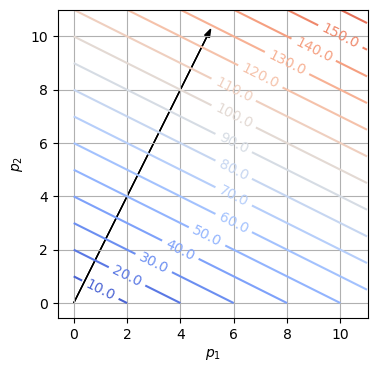Code
import numpy as np
import matplotlib.pyplot as plt
import sympy as sp
import numpy.linalg as linalgSei \(v_1 = \begin{pmatrix}1 \\ 2 \\ 3 \end{pmatrix}, v_2 = \begin{pmatrix} 4 \\ 5 \\ 6 \end{pmatrix}\) und \(v_3 = \begin{pmatrix} 2 \\ 1 \\ 0 \end{pmatrix}\).
Betrachten Sie die lineare Funktion \(f:\mathbb{R}^2 \rightarrow \mathbb{R}: f(x) = 2x_1 - x_2\).
Wir nehmen an, daß die Temperatur \(T\) (gemessen über Raumtemperatur, beispielsweise \(T = 30\) Grad Celsius bedeutet 30 Grad Celsius über der Raumtemperatur) eines Computers mit zwei verschiedenen Prozessoren eine lineare Funktion der Leistungen \(p = (p_1, p_2)\) der zwei Prozessoren ist. Wenn beide Prozessoren im Leerlauf sind ist \(p = (2,2)\), was zu einer Temperatur \(T = 30\) Grad Celsius führt. Wenn der erste Prozessor mit voller Leistung arbeitet und die andere im Leerlauf ist, ist \(p = (8,2)\) und die Temperatur steigt auf \(T = 60\) Grad Celsius.
Die Vektoren \(v_i\) sind linear unabhängig, falls das lineare Gleichungssystem \(\alpha_1 v_1 + \alpha_2 v_2 + \alpha_3 v_3 = 0\) für die Koeffizienten \(\alpha_i \in \mathbb{R}\) nur die triviale Lösung \(\alpha_i = 0\) hat.
In komponenten ausgeschrieben lautet die Vektorgleichung \(\alpha_1 v_1 + \alpha_2 v_2 + \alpha_3 v_3 = 0\)
\[ \alpha_1 \begin{pmatrix} 1 \\ 2 \\ 3 \end{pmatrix} + \alpha_2 \begin{pmatrix} 4 \\ 5 \\ 6 \end{pmatrix} + \alpha_3 \begin{pmatrix} 2 \\ 1 \\ 0 \end{pmatrix} = \begin{pmatrix} 0 \\ 0 \\ 0 \end{pmatrix}. \]
In Gleichungsform:
\[\begin{align} \alpha_1 + 4 \alpha_2 + 2 \alpha_3 & = 0 \\ 2 \alpha_1 + 5 \alpha_2 + \alpha_3 & = 0 \\ 3 \alpha_1 + 6 \alpha_2 & = 0 \end{align}\]
In Matrixform:
\[\begin{pmatrix} 1 & 4 & 2 \\ 2 & 5 & 1 \\ 3 & 6 & 0 \end{pmatrix} \begin{pmatrix} \alpha_1 \\ \alpha_2 \\ \alpha_3 \end{pmatrix} = \begin{pmatrix} 0 \\ 0 \\ 0 \end{pmatrix}\]
Das lineare Gleichungssystem läßt sich z. B. mit dem Gaußschen Eliminationsverfahren lösen. Der Lösungsraum ist eindimensional und kann z. B. mit \(\alpha_3\) parametrisiert werden:
\[\begin{align} \alpha_1 & = 2 \alpha_3 \\ \alpha_2 & = - \alpha_3 \\ \alpha_3 & = \text{frei wählbar} \end{align}\]
Das lineare Gleichungssystem \(\alpha_1 v_1 + \alpha_2 v_2 + \alpha_3 v_3 = 0\) hat daher auch nicht-triviale Lösungen, z.B. mit \(\alpha_3 = -1\) gilt \(-2 v_1 + v_2 - v_3 = 0\). Daher sind die Vektoren linear abhängig.
# The command solve() can solve quadratic matrix equations Ax=b
# only when Ax=b has a unique solution. This is the case
# if and only if (short iff) the columns of A are linearly independent.
A = np.array([[1, 4, 2],
[2, 5, 1],
[3, 6, 0]])
b = np.zeros((3,1))
linalg.solve(A, b) # gives the trivial solution array([[ 0.],
[ 0.],
[-0.]])\(\displaystyle \left\{\left( 2 a_{3}, \ - a_{3}, \ a_{3}\right)\right\}\)
# x1-x2-Grid:
delta = 0.25
x1 = np.arange(-5.0, 5.0, delta)
x2 = np.arange(-5.0, 5.0, delta)
X1, X2 = np.meshgrid(x1, x2)
# Koeffizientenvektor:
c = np.array([2, -1])
# c = array([2, -1])*3 # Skalieren von c damit die Konturlinien näher zueinander liegen
# c = array([2, -1])*0.2 # Skalieren von c damit die Konturlinien weiter voneinander liegen
# y = f(x) = c^T x:
Y = c[0]*X1 + c[1]*X2
# Plot:
plt.figure()
plt.axis('equal')
plt.arrow(0, 0, c[0], c[1], head_width=0.2, fc='k')
CS = plt.contour(X1, X2, Y, levels= [-2,0,2,4], cmap='coolwarm')
plt.clabel(CS, inline=1, fmt='%1.1f')
plt.xlabel('$x_1$')
plt.ylabel('$x_2$')
plt.grid(True)
Die Temperatur wird als eine lineare Funktion der Leistungen \(p = (p_1, p_2)\) modelliert: \(T(p) = c_1 p_1 + c_1 p_2\). Einsetzen der zwei Messdaten in die Funktionsgleichung liefert:
\[\begin{align} c_1 2 + c_2 2 & = 30 \\ c_1 8 + c_2 2 & = 60 \end{align}\]
Das lineare Gleichungssystem ist eindeutig lösbar: \(c = \begin{pmatrix} 5 \\ 10 \end{pmatrix}\), siehe auch Code. Somit lautet die Funktionsgleichung \(T(p) = 5p_1 + 10p_2\).
Siehe Code.
Bei gleicher Leistung \(p\) beider Prozessoren gilt \(p_1 = p_2 =p\). Die Forderung, dass die Temperatur unter 90 Grad Celsius sei, bedeutet \(5p + 10p < 90\) und hat die Lösung \(p<6\). Somit kann die gleiche Leistung beider Prozessoren maximal 6 sein, damit die Temperatur unter 90 Grad Celsius ist.
[[ 5.]
[10.]]# contour lines of T(p) = 5p_1 + 10p_2:
delta = 1
p1 = np.arange(0, 12, delta)
p2 = np.arange(0, 12, delta)
P1, P2 = np.meshgrid(p1, p2)
T = c[0,0]*P1 + c[1,0]*P2
plt.figure()
plt.axis('equal')
plt.arrow(0, 0, c[0,0], c[1,0], head_width=0.2, fc='k')
CS = plt.contour(P1, P2, T, levels= np.arange(0, 200, 10), cmap= 'coolwarm') # colormaps()
plt.clabel(CS, inline=1, fmt='%1.1f')
plt.xlabel('$p_1$')
plt.ylabel('$p_2$')
plt.grid(True)